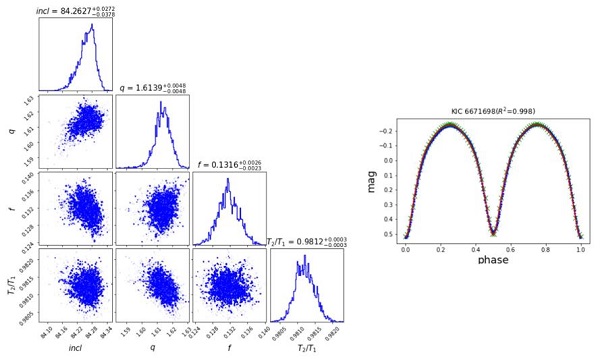Recently, Dr. DING Xu, Prof. JI Kaifan of Yunnan Observatories, Chinese Academy of Sciences (CAS), and postdoc LI Xuzhi of the University of Science and Technology of China have used machine learning methods to quickly obtain the parameters and errors of contact binaries. This study was published in The Astronomical Journal.
A contact binary is a strongly interacting binary system with two component stars filled with Roche lobes, and there is a common envelope around the component stars. With the release of thousands of light curves of contact binaries, if the current Wilson – Devinney or Phoebe program is used to derive the parameters of contact binaries, the time to derive the parameters of one target can be as long as several hours or days. Therefore, we need a fast method to derive the parameters of contact binaries for such a large number of light curves.
The researchers first used a neural network (NN) to establish the mapping relationship between the parameters of the contact binary stars and the light curves, and obtained one model without the influence of the third light and one model with the influence of the third light, respectively. The accuracy of the light curves generated by these two models is less than one thousandth of the magnitude, and the parameters and corresponding errors of the contact binaries can be quickly obtained by combining the Markov chain Monte Carlo algorithm (MCMC). Compared with the traditional methods, this method not only meets the requirements in accuracy, but also improves the speed by four orders of magnitude under the same running condition.
This method makes it possible to derive the parameters of a large number of contact binaries. Next, the researchers will conduct statistical analysis of the contact binaries in the TESS survey data of the space telescope and the ZTF survey data of the ground telescope.
This research work has been funded by the National Natural Science Foundation of China and the China Manned Space Project.
Contact:
DING Xu
Yunnan Observatories, CAS
Email: dingxu@ynao.ac.cn

Left: posterior distributions of parameters of KIC 6671698 (nol3) are obtained by NN model and the MCMC algorithm.
Right: KIC 6671698 fitting results. The blue dots are the original light curve. The red line is the light curve generated by NN model. The x points are the light curve generated by Phoebe.